The Three-Body Problem of Data: Why Analytics, Decisions, & Ops Never Align
Significance of the Action Layer, Fitness Test for AI-Readiness, and the Leverage of an Operating System for Data Apps Woven Through Agentic Workflows
This piece is a community contribution from Sachin Dharmapurikar, a seasoned engineering leader with 20+ years of experience driving AI-led transformation, developer productivity, and product growth. As Head of Client Technology at The Modern Data Company and former leader at Thoughtworks, he’s shaped frameworks like EEBO and pioneered Engineering Effectiveness at scale. We deeply appreciate his contribution and commitment to sharing his expertise with Modern Data 101.
We actively collaborate with data experts to bring the best resources to a 10,000+ strong community of data practitioners. If you have something to say on Modern Data practices & innovations, feel free to reach out!
🫴🏻 Share your ideas and work: community@moderndata101.com
*Note: Opinions expressed in contributions are not our own and are only curated by us for broader access and discussion. All submissions are vetted for quality & relevance. We keep it information-first and do not support any promotions, paid or otherwise!
The Failed Orchestra of Our Three Worlds
Most systems aren’t broken. They’re worse: they almost work. As a veteran salesforce user the first thing you do is download as Excel and operate from there. Two people will slice PowerBI data differently and land on entirely different insights. Then, the ML system makes a prediction: demand will rise, a device is at risk, an order will likely fail. And the prediction is not wrong.
But by the time someone actually does something about it, it’s already irrelevant. Ops teams continue in their world, raising tickets in ServiceNow, responding to issues that surfaced three days ago. Everyone’s working hard. Everyone’s acting on something. But they’re never acting on the same thing, or at the right time within the necessary window.
This is the orchestra. The analytics team is playing classical, AI/ML is improvising jazz, and operations is still tuning their instrument. The conductor, if there is one, is buried under unread dashboards and unclicked PDFs. What we call “insight” today has a half-life and in most companies, we waste it. You get a signal, you analyze it, and you build a neat chart. Maybe you even present it.
But if it’s not acted on within a narrow window across the business’s workflow spanning all three worlds: from data to operation, then it ages out like yesterday’s newspaper. The data was good. The dashboard was clean. But no action followed.
It's not about tool failure, it’s about human trust and system timing. People see the data the way they want to see it. They read what confirms their lens. One person’s insight is another person’s background noise. So, the feedback loops are broken, predictions sit idle, and operations move forward as if none of it happened. The platforms don’t speak to each other. Worse is they don’t even realize they’re playing in different rooms.
The Three Worlds of Data
Every modern company lives in three parallel realities: three worlds that collect, compute, and act on data in completely different ways. They’re not wrong. They’re just misaligned. And without a shared rhythm, the system stutters.
Analytical Systems
The first is the world of analytics: reports, dashboards, BI tools. This is where data is historical, visual, and increasingly ornamental. You log into Snowflake or BigQuery, layer on a Looker chart, and walk into a meeting armed with confidence. It tells you what happened last quarter, why last week’s sales dipped, which category underperformed. It’s crisp, visual, and often accurate but it's not wired to intervene. No matter how beautiful the chart, it doesn’t raise a PO, escalate a delay, or nudge a system back to health.
The analytics world rarely flows into systems that do something or act. In most companies, analytics is still an export function: data goes from platform to PowerPoint to inbox
Decision or Prediction Systems
This world tries to look ahead. Think of machine learning models, forecasting engines, or inventory optimization logic buried deep in supply chain software. These systems do more than report — they attempt to anticipate. The e-commerce category manager, for instance, knows which book titles are trending and when they’ll run out of stock. Their job is to forecast the future: what will sell, what won’t, and what needs to be sourced now to meet next month’s demand. But even here, there’s a limit. Prediction systems might know that a SKU is about to go out of stock, but they can’t place the order or flag logistics.
They emit signals, but rely on someone else to hear and act. Because it can predict that a shipment will fail, but it can’t prevent it. It knows the train is off-track. But it doesn’t hit the brake.
Operational Systems
Operations is where the business breathes. This is the domain of ERPs, order management systems, warehouse dashboards, and ticketing queues. It doesn’t care what the model predicted or which dashboard lit up. It cares whether the delivery arrived, whether the device failed, whether the ticket was closed. It's deeply embedded in the moment reacting, resolving, routing. For instance, in production or supply chains, this is where temperature checks, delivery SLAs, and compliance flags live.
But it often has no idea that an insight was generated or a prediction was made, or that a signal was raised upstream. It acts on process standards instead of business intelligence. It’s running blind or on outdated instructions.
Together, these three worlds form the full data stack of an enterprise. But without a bridge or a common layer to translate and act, each world becomes a silo. The dashboard knows. The model guesses. The ops team improvises. And the business moves forward, out of sync with itself.
Case in Point: Same Supply Chain, Three Disconnected Systems
Let’s take a company that manages supply chains for multiple brands, say pharma, electronics, auto parts. Each category has its own head. Each head works with different vendors: warehouses, freight, packaging. It’s a web of dependencies.
Now imagine this: a truck is running late. Inventory scan shows a mismatch. 20 orders might not make it to delivery. At 2:00 PM, the delivery manager gets a call, “Do we reroute? Do we wait? Do we split shipments?”
She opens the analytics dashboard. It tells her that yesterday, the east warehouse missed SLAs by 3.2%. But this insight isn’t woven well or woven at all into the operational system data that the manager tracks.
She checks the predictive tool. The model says: this vendor tends to miss pickups on Tuesdays. It doesn’t auto-trigger a route change, it doesn’t block a faulty batch, it doesn’t do anything on its own.
The manager doesn’t need insights from yesterday or tendencies from last month. She needs a call to action. Now.
Who’s integrating that information and converting it into a decision? Nobody.
Operations is overloaded, waiting for a trigger.
Analytics is still stuck summarizing the past.
Prediction systems are nudging—but not executing.
Each system knows something, but none of them are built to act together in the moment. So the manager does what every manager ends up doing: goes with her gut, makes the call, and hopes it doesn’t snowball downstream.
That’s the problem. Forecasts and dashboards are passive. Predictions are passive. And when it matters most, when a human in the loop needs to decide, none of these systems step up.
The three worlds must work in sync. The platform must bring context + prediction + action into one loop. Otherwise, you’re managing a real-time supply chain with lagging tools and disconnected voices. And the moment always slips past.
Everyone Is Still Running on Excel
There’s a factory floor somewhere where a supply chain worth millions is being run on a spreadsheet. Not a modern grid app. Not a fancy dashboard. Just Excel. And not even “Excel as an interim tool”, but Excel as the system.
Take appliance manufacturing. One finished unit might involve 200 components, each sourced from different suppliers: let’s say some in China, some in Korea, a few in Germany. Every supplier has their own capacity limit, delivery cycle, pricing model. The production manager? They’re juggling all of this inside one Excel workbook. Tracking component inventory. Cross-referencing supplier constraints. Trying to answer the only question that matters: can I build the next batch on time?
You wouldn't believe that such big production companies are having Excel to power their most critical part of their operations. And there are even instances when critical decisions are at jeopardy because they hit the limit of the number of rows in one Excel sheet. So, a lot of craziness in the world right now.
But people still use Excel because it gives them something most enterprise systems don’t: control. It’s flexible. It’s local. It doesn’t require a ticket or a training session. And most importantly, it reflects their mental model of the process, not some vendor’s templated version.
Excel is not a tool. It’s an emotion. It’s the one place where the process manager feels like they’re in charge until they aren’t.
The Fitness Test for AI-Readiness
Ask ten companies what AI-readiness means and you’ll get ten different answers. For some, it’s dashboards with predictive insights. For others, it’s natural language agents that talk like product managers and execute like engineers. Everyone has their own definition of AI. And that's the problem.
Your AI is your faith.
Everyone believes they’re doing it. Few are asking what it takes to do it right. We break it down into three levels: non-negotiable, competitive, and aspirational.
Basic or Table Stakes: Fast, Clean, Reliable Data
This isn’t optional. If you don’t have clean, fast access to trusted data, you’re already behind. In 2025, if a team can’t pull reliable data in real time without chasing three people and five files, what AI are we even talking about?
This is the part most orgs still don’t have in place. Slow access breaks trust, delays action, and kills relevance. Predict all you want, but if your sales manager opens the sheet 24 hours later, it’s a missed train.
State of the Art: Unified Data Platforms
This is where you align the three worlds: analytics, prediction, and operations, on one surface where action unfolds.
You don’t just build pipelines, you build data products. Call it a mesh, a fabric, or a platform, it’s the place where context, logic, and action meet. This layer is what separates functioning companies from reactive ones.
If you don’t have a unified layer, you’re still copying dashboards into Slack and asking ops managers to “take a look when free.” The system hasn’t moved the needle when a human still acts as the bridge instead of taking high-impact decisions.
Aspirational: Agentic Systems
This is where systems act. Not just recommend or alert, but act. These are systems that don't just inform humans but execute on behalf of them. A model doesn’t just say “the east zone will miss delivery targets,” it reroutes, reprioritizes, or alerts the right people. In real time.
Not everything needs to be automated. But if everything needs manual intervention, you’re not building for scale. You’re bottlenecking on human bandwidth. Think RAG, agentic flows, natural language interfaces, autonomous action.
If you’re not investing in fast, reliable access, don’t talk about agents.
If your data platform doesn’t unify the stack, don’t talk about autonomy.
AI-readiness isn’t a slogan. It’s a simple systems test. And you either pass in the moment, or you don’t.
The Why of Aspiring to Be Agentic
Most companies want AI to sound good in a boardroom. Few ask what it takes to move the needle in ops. Here’s the real reason to aspire toward agentic systems: it’s not about sophistication. It’s about not losing money while waiting for someone to act.
Let’s take a large retail chain. Think 6,000 to 7,000 POS devices. Now in this world, checkout uptime isn’t a vanity metric. If a POS terminal fails, the customer walks out. If 200 terminals fail across 20 cities, the financial hit is real. And what usually happens?
The store staff calls IT. The manager raises a ticket. Regional ops get involved. Every step delays the fix. Every step incurs cost. Even a missed call to the helpdesk gets billed.
So here’s the question: Why should a human even have to call? That’s where agentic systems change the equation.
POS terminals generate telemetry in real time: printer status, network lag, power surges, error rates. All this is piped into a unified data platform. A model trained on historic failures flags which terminals are likely to go down in the next two hours.
But prediction alone isn’t the game-changer. It’s what happens next.
The platform maps all at-risk devices by location. Let’s say 200 are flagged. A field visit costs $100. But 80 of those can be fixed remotely with a reboot, firmware patch, or cache clear. So the system:
Filters which devices can be recovered without human intervention,
Executes those actions instantly, via remote interfaces,
And closes the loop without opening a single ticket.
The store manager doesn’t even know something was wrong. That’s the point.
When you bring analytics (telemetry), prediction (failure scoring), and operations (remote remediation) into one data app, you stop talking about “AI use cases” and start reducing cost per incident.
You don’t aspire to be agentic to look smart or be relevant to trends. You do it so your system acts before your people have to, it’s an investment and undoubtedly a high-impact ROI strategy.
Meet the Protagonist: The Action Layer
Everyone’s building systems that report. Few are building systems that respond.
Most enterprises have three disconnected engines running: analytics that tell you what happened, ML that tries to predict what might happen, and operations where reality unfolds every minute. But the moment you ask, “Who actually did something based on this insight?”, there’s usually no answer or a vague one with non-existent transparency.
That’s the problem the Action Layer is designed to solve.
Not just the union of analytics, machine learning, and ops. But the moment these systems converge on a unified execution surface, built to act, not just report. It’s what emerges when your data platform stops being a silent archive and starts running the business.
The Nervous System Analogy
If we must draw a metaphor, make it functional, the enterprise nervous system has:
Sensors → Your analytics: signals, events, telemetry.
Reflexes → ML systems: models that flag what needs attention.
Muscles → Operational systems: APIs, levers, interfaces that execute.
But the brain is the one that decides, reacts, and pushes buttons. This is the Action Layer.
Without it, the rest is just noise. You’ve got all the information, but no action. You’ve got predictions, but no response. That’s the cost of running systems in silos.

Action Layer = Operating System of Data Apps That Act with Agency
Let’s be clear that these apps are not dashboards with a prettier UI. These are apps with agency. Built on top of a unified data platform. Containerized. Pluggable. Embedded right into the day-to-day flow.
They don’t just highlight problems. They fix them. For instance:
Detect POS failures via telemetry → Push firmware patches remotely
Flag low inventory from predictive signals → Trigger auto-replenishment workflows
Spot SLA violations in supply chain → Auto-escalate to the right resolution tier
They don’t sit in a separate system. They show up where the action is: right inside the operator’s tool, at the exact moment a decision needs to be made.
The bottom line is our businesses don’t run on insight. They run on actions taken based on those insights. Everything else is academic.
You can have a hundred brilliant ideas (or insights), but the world only changes when you choose to act. Vision matters, but the work is what history remembers.
Final Note: Action Is the New Insight
Dashboards don’t drive revenue. Decisions do.
And not decisions floating in slide decks, but ones that reach the real world and move something.
Amazon doesn’t get paid for having the smartest ML. Amazon knows. But Amazon doesn't get paid to show good recommendations. They get paid when people actually buy. The system knows you’re looking at an expensive fountain pen. So it shows you a premium journal. Then a leather bag. That’s not random. It’s intent detection. But all that prediction? It’s worth zero until you tap Buy Now.
The job of data systems is to make the business act smarter. That means surfacing the right insight at the point of execution and closing the loop then and there. Anything less is just potential. And potential doesn’t show up in your quarterly numbers.
MD101 Support ☎️
If you have any queries about the piece, feel free to connect with the author(s). Or feel free to connect with the MD101 team directly at community@moderndata101.com 🧡
Author Connect 🖋️
Find me on LinkedIn 🤝🏻
More from Sachin
Find it on Amazon US and Kindle here ↗️
Related Reads
The Reflexive Supply Chain Stack: Sensing, Thinking, Acting
The Great Disruption: When COVID hit, the first visible cracks weren’t in hospitals or stock markets; they were in supermarket aisles. Suddenly, toilet paper disappeared. And no one really knew why. That’s how it begins: with demand-supply shifts that no one knows to model. Shifts that cannot be anticipated, yet need to be dealt with at scale.


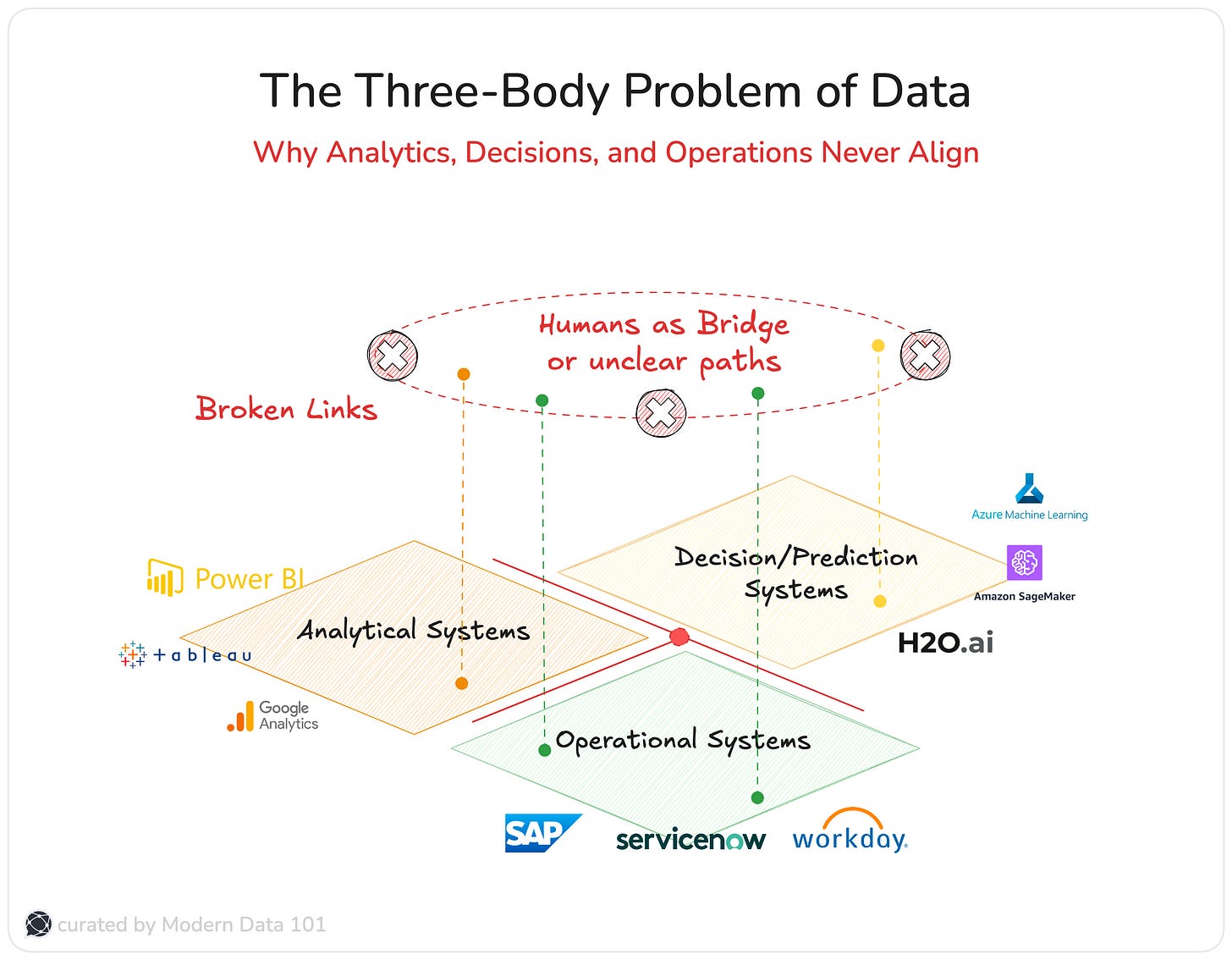

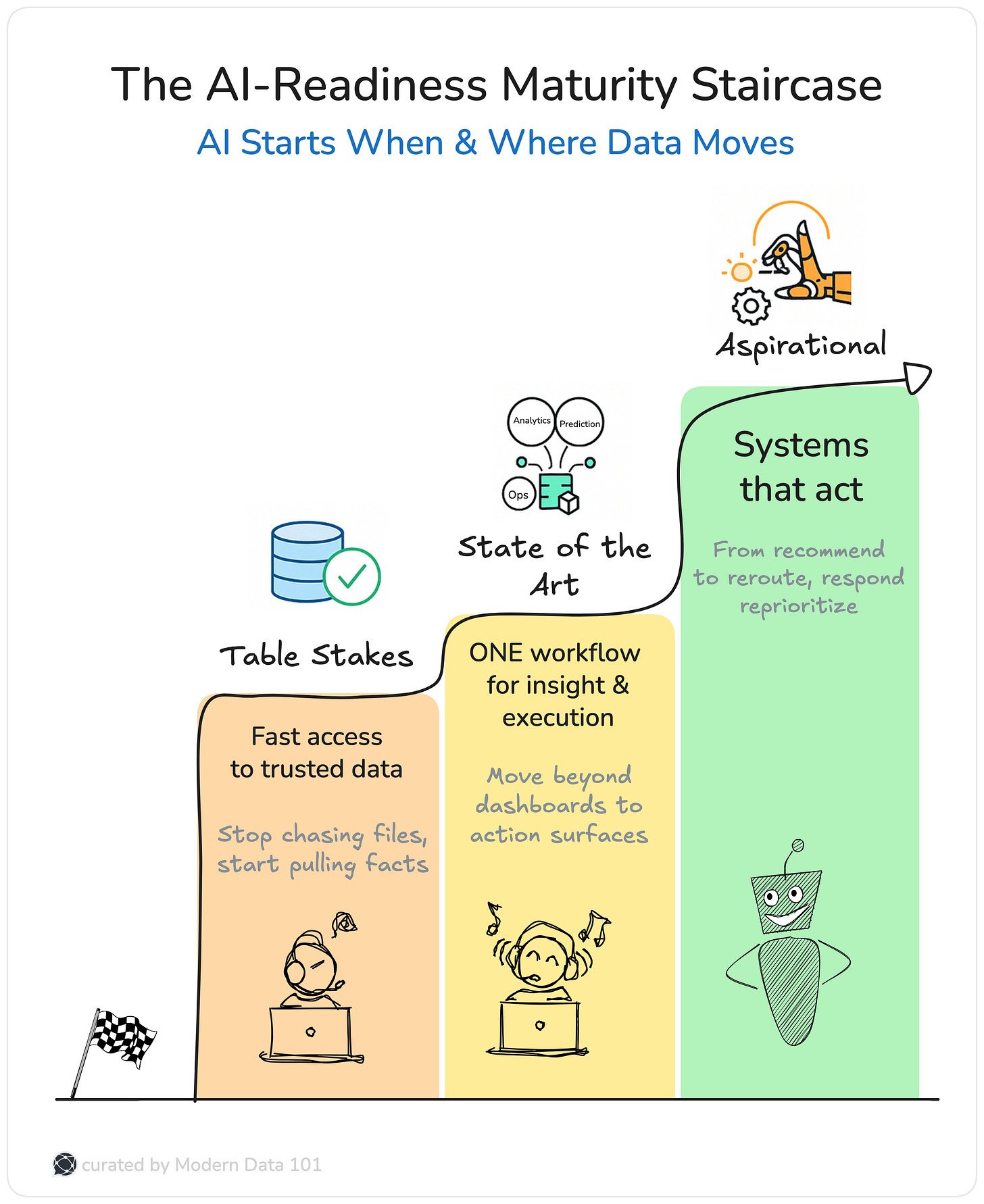
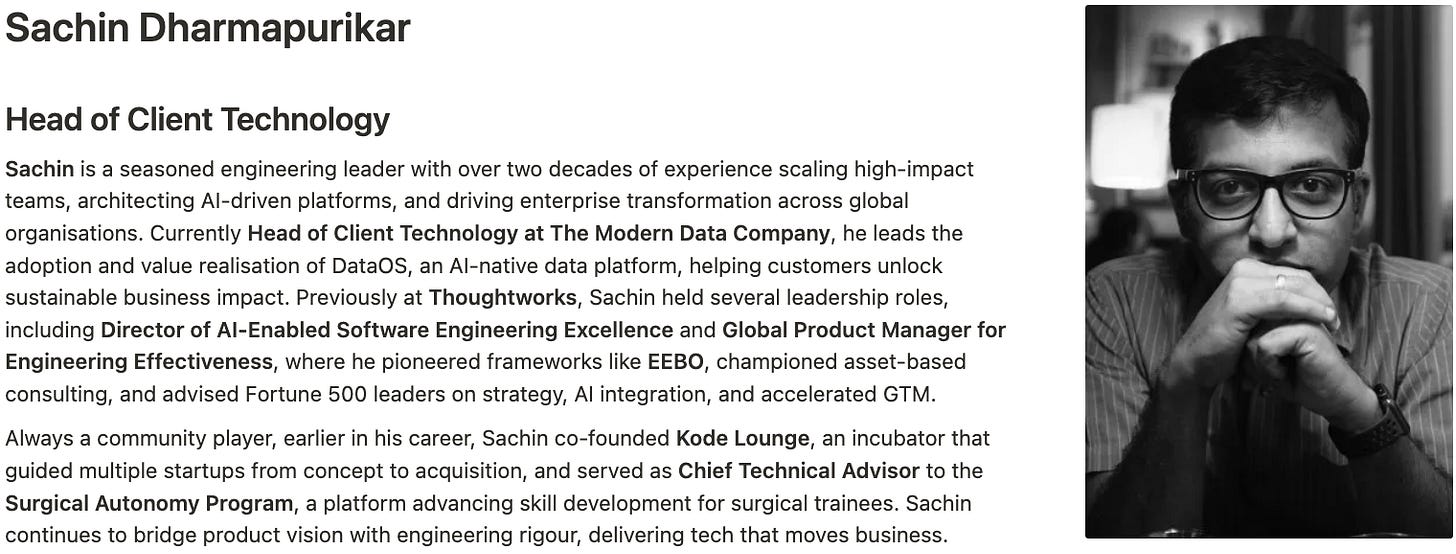
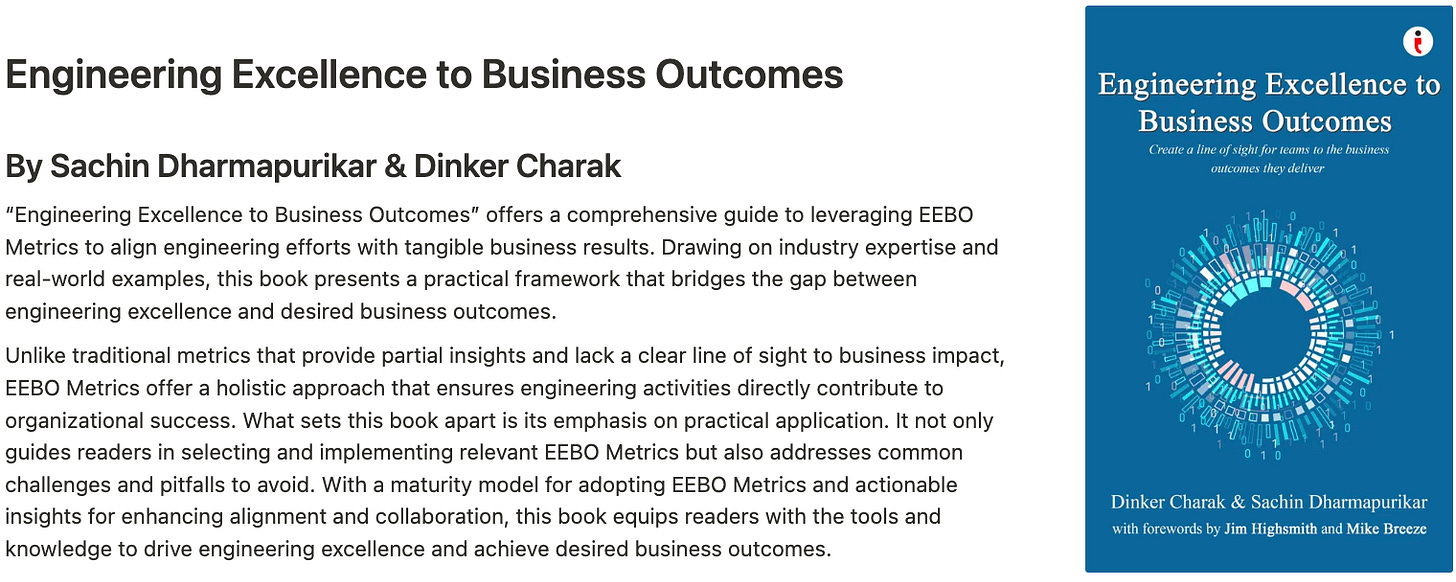
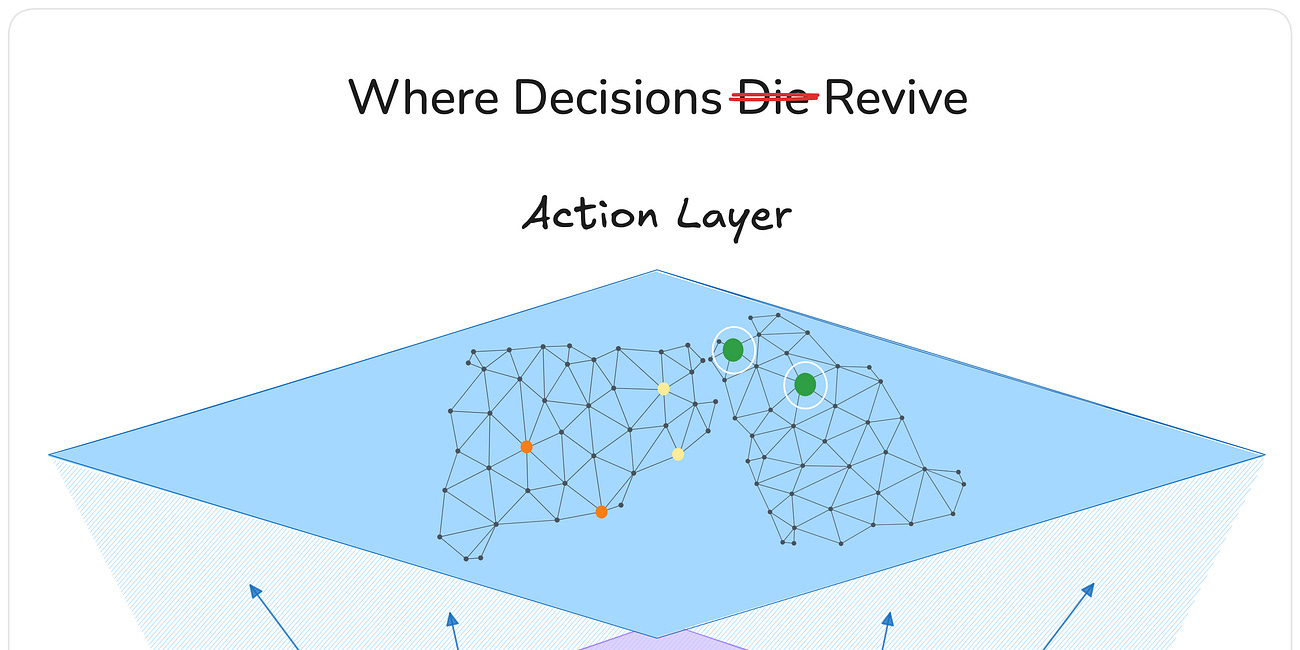

Reading this piece is like going through my sales calls from the last three years, as a Governed Semantic Layer is inherently a logic/knowledge layer necessary for aligning these 3 bodies which of course stretch across domains.
For example, in my world, when discussing architecture frameworks to address this three-body problem, I would argue for a Governed Semantic Layer in the stack that turned the domains into interconnected semantically aligned micro kg's and state that a Governed Semantic Layer would:
-Aligns terms across BI dashboards, ML features, and Ops systems
-Validates policies before actions or predictions are taken
-Feeds AI with grounded, explainable knowledge
-Provides decision traceability across all three “bodies”
But you would still need other layers to complete the picture with other layers.
Saved! Looking forward to reading it